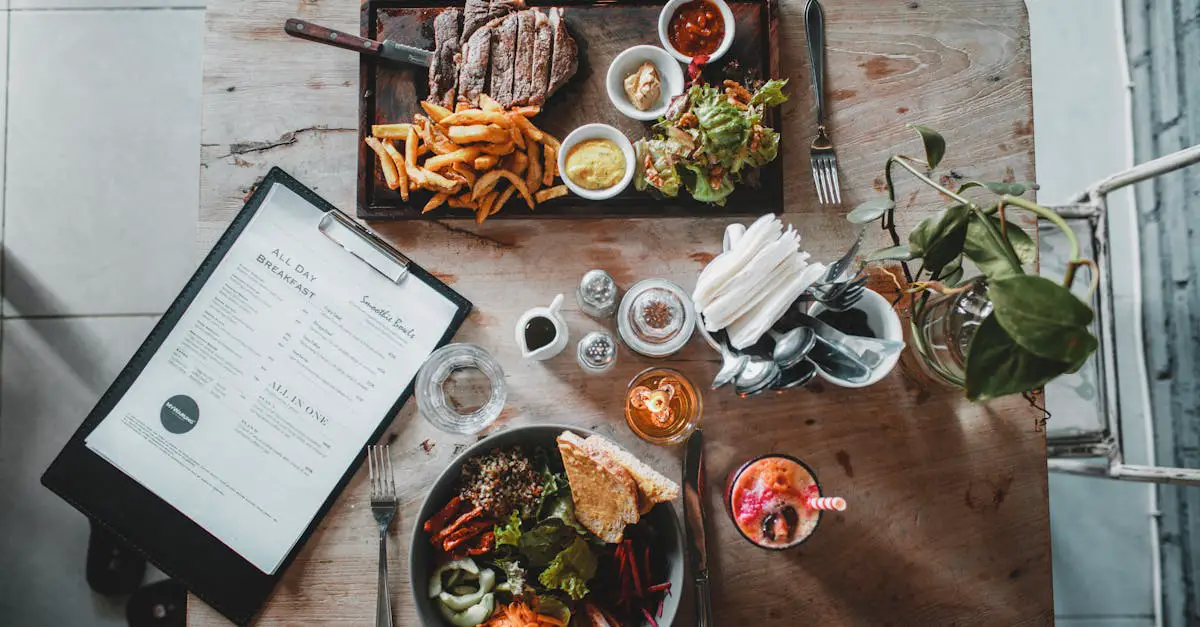Originally posted on April 30, 2025 @ 9:22 am
Exploring a Creole kitchen menu is like taking a flavorful journey through a rich cultural heritage. We get to experience a unique blend of French, African, Spanish, and Native American influences that come together in every dish. The bold spices and fresh ingredients create meals that are both comforting and exciting.
When we dive into a Creole menu, we find classics like jambalaya, gumbo, and red beans and rice. These dishes tell stories of tradition and community, each bite packed with history and heart. Whether we’re seasoned food lovers or new to Creole cuisine, the menu offers something that sparks curiosity and satisfies cravings.
Overview of Creole Cuisine
Creole cuisine showcases a rich tapestry of history and culture, blending diverse culinary traditions into bold, flavorful dishes. This cuisine defines itself through unique origins and distinctive ingredients that create unforgettable tastes.
Origins and Influences
Creole cuisine traces its roots to New Orleans, Louisiana, where French, Spanish, African, and Native American cultures merged. Each group contributed unique cooking techniques, spices, and ingredients that shaped Creole cooking into a vibrant culinary tradition.
- French Influence: Introduced classic sauces, roux-based dishes, and refined cooking methods.
- Spanish Influence: Brought hearty stews and the use of rice as a staple.
- African Influence: Added bold spices, okra, and one-pot cooking styles.
- Native American Influence: Contributed local seafood, game, and indigenous herbs.
“Creole food reflects centuries of cultural fusion, each bite telling the story of its origins.”
This blend of backgrounds fosters a diverse menu rooted in tradition, community, and innovation.
Key Ingredients and Flavors
Creole dishes rely on a combination of fresh, locally sourced ingredients and aromatic spices enhancing vibrant flavor profiles:
| Ingredient Category | Examples | Flavor Contribution |
|---|---|---|
| Vegetables | Bell peppers, onions, celery | Form the “holy trinity,” base flavors |
| Proteins | Shrimp, chicken, andouille sausage | Provide depth, texture, and richness |
| Spices & Herbs | Cayenne pepper, thyme, bay leaves | Add heat, earthiness, and aroma |
| Staples | Rice, tomatoes, okra | Build body and enhance heartiness |
The use of a dark roux—a caramelized flour and fat mixture—appears in many dishes, imparting a signature nutty taste. Creole cuisine contrasts with Cajun by incorporating more tomatoes and a wider variety of spices, creating complex layers of flavor.
Every ingredient harmonizes to craft dishes that range from savory gumbo to zesty jambalaya, satisfying diverse palates with every bite.
Exploring the Creole Kitchen Menu
Creole cuisine offers a spectrum of bold flavors and textures that captivate taste buds. The menu reflects its rich heritage through distinctive starters, hearty mains, complementary sides, and indulgent desserts.
Popular Starters and Appetizers
Starters in the Creole kitchen set the tone with vibrant, spicy flavors. We often find:
- Shrimp Remoulade: Chilled shrimp tossed in a zesty, mustard-based remoulade sauce.
- Fried Green Tomatoes: Crispy, tangy slices served with Creole-seasoned dipping sauces.
- Boudin Balls: Spicy pork and rice sausage formed into balls and deep-fried.
- Crab Cakes: Lump crab meat, herbs, and spices pan-fried to golden perfection.
These appetizers incorporate the holy trinity of Creole vegetables—bell peppers, onions, and celery—adding depth right from the start. Their bold use of cayenne and paprika introduce guests to the menu’s signature heat levels.
Signature Main Dishes
Main courses showcase Creole cuisine’s complexity and heartiness with diverse proteins and rice combinations. Popular classics include:
| Dish | Description | Key Ingredients |
|---|---|---|
| Jambalaya | A rice-based one-pot dish blending meats, seafood, and spices | Andouille sausage, chicken, shrimp, rice, tomatoes |
| Gumbo | A thick, stew-like dish with dark roux and varied proteins | Okra, sausage, seafood, dark roux, Creole spices |
| Red Beans and Rice | Slow-cooked kidney beans simmered with spices and pork | Red beans, smoked ham, rice, celery, onions |
| Shrimp Creole | Steamed shrimp in a spicy tomato sauce served over rice | Shrimp, tomatoes, bell peppers, garlic, cayenne |
Each dish balances fresh herbs, aromatic spices, and local proteins. The inclusion of tomatoes and a savory roux sets Creole mains apart from related Cajun fare.
“Creole main dishes reflect our cultural mosaic—every bite tells a story of heritage and hospitality.”
Traditional Sides and Accompaniments
Sides complete the meal by complementing the boldness of mains. We commonly enjoy:
- Cornbread: Slightly sweet and crumbly, perfect for soaking up sauces.
- Collard Greens: Simmered with smoked meat and spices, offering earthy contrast.
- Hush Puppies: Deep-fried cornmeal balls seasoned with herbs and onions.
- Potato Salad: Creamy with a hint of mustard and celery for crunch.
These sides frequently use similar seasoning as mains, reinforcing consistent flavor profiles throughout the meal.
Desserts and Sweet Treats
Desserts in Creole cuisine combine sweetness with subtle spice and rich textures:
| Dessert | Description | Typical Ingredients |
|---|---|---|
| Beignets | Deep-fried pastries dusted with powdered sugar | Flour, yeast, sugar, powdered sugar |
| Bread Pudding | Custard-soaked bread baked and topped with whiskey sauce | Bread, eggs, milk, cinnamon, whiskey sauce |
| Pecan Pie | Sweet pie with a rich, nutty filling | Pecans, corn syrup, brown sugar, butter |
| Bananas Foster | Bananas sautéed in rum and brown sugar, flambéed | Bananas, rum, butter, brown sugar, cinnamon |
These desserts highlight regional ingredients such as pecans and spices like cinnamon, creating satisfying finishes to any Creole meal.
Our exploration confirms that the Creole kitchen menu thrives on harmonious blends of spices, local produce, and diverse influences. From starters to sweets, every dish embodies the cultural vibrancy and culinary mastery defining Creole cuisine.
Dietary Options and Customizations
Creole cuisine embraces diverse dietary needs without sacrificing its bold flavors and traditional character. We explore vegetarian, vegan, gluten-free, and allergy-friendly options that maintain the authenticity of the Creole kitchen menu.
Vegetarian and Vegan Choices
Vegetarian and vegan dishes in Creole cooking showcase the vibrant use of local vegetables, legumes, and spices. We find plant-based alternatives that honor the Creole spirit by utilizing the holy trinity of bell peppers, onions, and celery as foundational ingredients. Popular dishes adapting well include:
- Vegetarian Gumbo: Prepared with okra, tomatoes, and a rich vegetable broth, seasoned with Creole spices.
- Red Beans and Rice (Vegan Version): Made with smoked paprika and vegetable sausage substitutes to retain depth.
- Creole Ratatouille: Combining eggplant, zucchini, and tomatoes, simmered with bold seasoning.
“Creole cuisine’s soul lies in its adaptability, allowing plant-based diets to savor authentic spice blends and hearty textures.”
| Dish | Key Ingredients | Vegan-Friendly | Notes |
|---|---|---|---|
| Vegetarian Gumbo | Okra, tomatoes, holy trinity | Yes | Uses vegetable broth and Creole seasoning |
| Vegan Red Beans & Rice | Red beans, smoked paprika, rice | Yes | Substitute traditional sausage with vegan |
| Creole Ratatouille | Eggplant, zucchini, bell peppers | Yes | Simmered with garlic and thyme |
Gluten-Free and Allergy-Friendly Options
Creole cuisine accommodates gluten sensitivities and common allergies by substituting ingredients and focusing on naturally gluten-free components. Dishes relying on rice, seafood, and vegetables inherently fit gluten-free requirements, while modifications avoid common allergens like shellfish or nuts.
- Gluten-Free Jambalaya: Made with rice, chicken, sausage, and Creole spices, omitting breadcrumb toppings.
- Seafood Gumbo (Nut-Free): Prepared with fresh shrimp, crab, and a gluten-free roux variant using rice flour.
- Cornbread (Gluten-Free Version): Cooked with almond or coconut flour ensuring texture and flavor without wheat.
| Dietary Need | Dish Example | Ingredient Swaps | Notes |
|---|---|---|---|
| Gluten-Free | Jambalaya | Rice flour roux, no breadcrumbs | Maintains traditional flavor |
| Nut Allergies | Seafood Gumbo | Gluten-free roux, no nuts | Uses rice flour, avoids nut garnishes |
| Dairy-Free | Collard Greens | No butter or cream | Cooked with olive oil and garlic |
Adapting Creole dishes preserves their authentic boldness while customizing for dietary restrictions. We find that even with alterations, the essence of Creole kitchen—marked by fresh herbs, spices, and local produce—remains intact and satisfying.
Dining Experience and Atmosphere
Our Creole kitchen menu comes alive through a dining experience steeped in Southern charm and cultural authenticity. Every visit immerses us in the warm hospitality and vibrant ambiance that define Creole restaurants, perfectly complementing bold flavors on our plates.
Ambiance and Decor
We find Creole dining spaces reflect New Orleans’ rich heritage through vivid decor and inviting settings. Bold colors like deep reds, greens, and golds dominate interiors, echoing Mardi Gras festivities and regional artistry. Traditional wooden furnishings paired with delicately wrought iron accents convey a rustic yet elegant feel. Locally inspired artwork, featuring jazz musicians, street scenes, and Creole culinary legends, adorns the walls, adding depth to the cultural story.
Soft, live jazz or zydeco music often fills the air, enhancing the festive mood while allowing conversation to flow effortlessly. Dimmed lighting and candle-lit tables foster intimate gatherings, suitable for family meals or celebratory dinners. Outdoor patios with lush greenery also captivate diners, especially in warmer months, blending nature’s tranquility with Creole vibrancy.
| Ambiance Elements | Description |
|---|---|
| Color Scheme | Rich reds, greens, golds reflect Mardi Gras influence |
| Furnishings | Wooden tables, wrought iron chairs combine rustic and elegance |
| Decor | Artwork depicting jazz, New Orleans street life |
| Music | Live jazz, zydeco setting an authentic Creole soundscape |
| Lighting | Soft, warm lighting promotes cozy, inviting atmosphere |
| Outdoor Space | Garden patios evoke Southern charm |
“The ambiance in a Creole kitchen mirrors the soul of New Orleans—it’s vibrant, soulful, and richly layered.”
Service and Presentation
We expect service to mirror Creole hospitality—friendly, attentive, and knowledgeable. Staff greeting us with genuine warmth and familiarity set a welcoming tone from the first moment. Servers expertly describe complex spice combinations and dish origins, enriching our culinary journey.
Plating elevates traditional Creole dishes through colorful, artful presentation. Meals arrive framed with fresh herbs and delicately placed garnishes like sliced green onions or vibrant bell pepper strips, showcasing the “holy trinity” of flavors. Bowls of gumbo steam invitingly, their dark roux hinting at deep flavor, while jambalaya bursts with brightly contrasting ingredients that delight the eyes and palate.
Timely service respects our dining pace without rushing, encouraging relaxed enjoyment and conversation. Portions balance generosity with refinement, ensuring satisfaction without overwhelming. Beignets dusted with powdered sugar or bread pudding drizzled with warm sauce close the experience as visually tempting as they are indulgently flavorful.
| Service Qualities | Presentation Features |
|---|---|
| Friendly & Attentive | Staff articulate dish ingredients and cultural background |
| Knowledgeable | Detailed menu guidance on spice levels and allergens |
| Artful Plating | Use of fresh herbs, colorful garnishes, and layered textures |
| Inviting Presentation | Steaming bowls, vibrant contrasts highlight dish appeal |
| Timely Service | Deliberate pacing enhances relaxed dining |
| Balanced Portions | Generous yet refined serving sizes |
“Creole service isn’t just about food delivery—it’s an experience of storytelling and cultural pride at every table.”
Our dining experience and atmosphere unite to form an immersive journey through Creole cuisine’s history and heartfelt hospitality, enriching the enjoyment of each bold flavor arriving at our table.
Conclusion
Exploring the Creole kitchen menu reveals a world where bold flavors and cultural heritage come together in every bite. It’s a cuisine that invites us to savor rich traditions while embracing modern dietary needs.
Whether you’re drawn to classic dishes or curious about plant-based Creole options, the menu offers something vibrant and satisfying for everyone. With its warm hospitality and lively atmosphere, Creole dining promises more than just a meal—it delivers an unforgettable experience.
Frequently Asked Questions
What is Creole cuisine?
Creole cuisine is a rich culinary tradition originating in New Orleans that blends French, African, Spanish, and Native American influences. It features bold spices, fresh ingredients, and signature dishes like jambalaya, gumbo, and red beans and rice.
How is Creole cuisine different from Cajun cuisine?
Creole cuisine uses a wider variety of spices and often includes tomatoes, while Cajun cooking tends to be spicier with simpler ingredients. Creole dishes are usually more refined, reflecting French culinary traditions.
What are the key ingredients in Creole cooking?
The “holy trinity” of bell peppers, onions, and celery is essential. Other common ingredients include shrimp, andouille sausage, cayenne pepper, thyme, tomatoes, and a dark roux for flavor.
Which dishes are most popular in Creole cuisine?
Popular dishes include jambalaya, gumbo, red beans and rice, shrimp Creole, shrimp remoulade, fried green tomatoes, and classic desserts like beignets and bread pudding.
Can Creole cuisine accommodate dietary restrictions?
Yes, Creole cooking adapts well to vegetarian, vegan, gluten-free, and allergy-friendly diets. Dishes like Vegetarian Gumbo, Vegan Red Beans and Rice, and Gluten-Free Jambalaya offer flavorful alternatives.
What is the dining atmosphere like in Creole restaurants?
Creole restaurants typically feature vibrant decor, Southern charm, live jazz or zydeco music, and friendly, knowledgeable staff, creating an immersive and festive dining experience.
What cultural influences shaped Creole cuisine?
Creole cuisine was shaped by French, African, Spanish, and Native American cultures, each contributing unique cooking styles, ingredients, and spices to create its distinct flavor profile.
What is the “holy trinity” in Creole cooking?
The “holy trinity” refers to the chopped trio of bell peppers, onions, and celery, forming the flavorful base for many Creole dishes.
Are there any traditional Creole desserts?
Yes, traditional Creole desserts include beignets, bread pudding, pecan pie, and bananas foster, all infused with regional flavors and spices.


